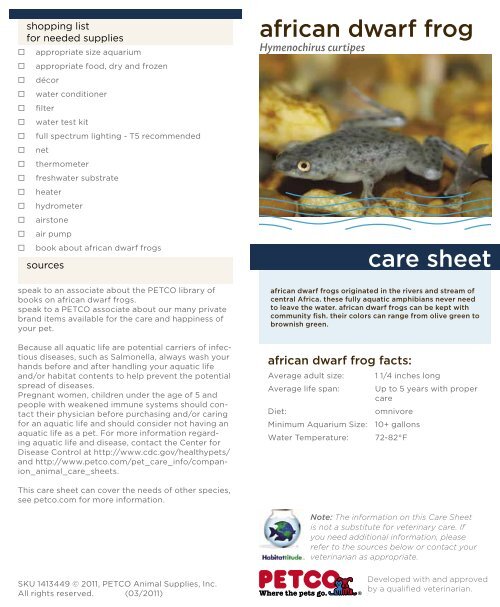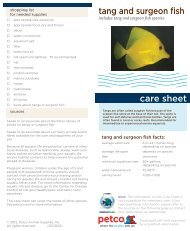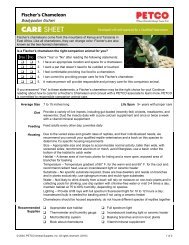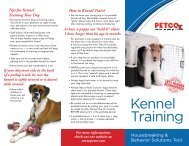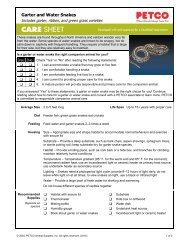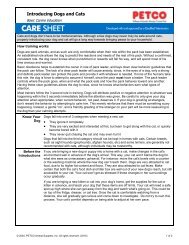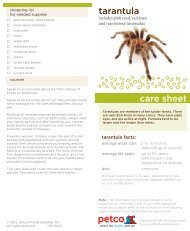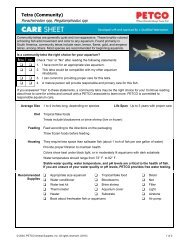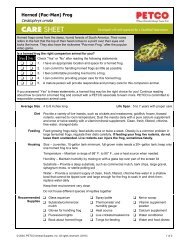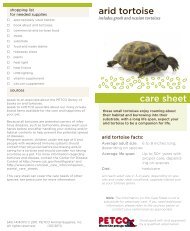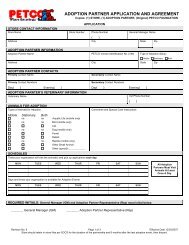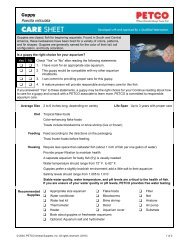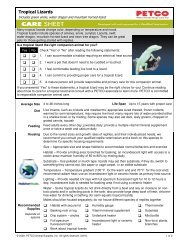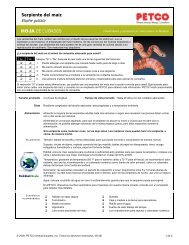african dwarf frog care sheet - Petco
african dwarf frog care sheet - Petco
african dwarf frog care sheet - Petco
Create successful ePaper yourself
Turn your PDF publications into a flip-book with our unique Google optimized e-Paper software.
shopping list<br />
for needed supplies<br />
<br />
appropriate size aquarium<br />
<br />
appropriate food, dry and frozen<br />
<br />
décor<br />
<br />
<br />
<br />
<br />
<br />
<br />
<br />
<br />
<br />
<br />
<br />
<br />
water conditioner<br />
filter<br />
water test kit<br />
full spectrum lighting - T5 recommended<br />
net<br />
thermometer<br />
freshwater substrate<br />
heater<br />
hydrometer<br />
airstone<br />
air pump<br />
book about <strong>african</strong> <strong>dwarf</strong> <strong>frog</strong>s<br />
sources<br />
speak to an associate about the PETCO library of<br />
books on <strong>african</strong> <strong>dwarf</strong> <strong>frog</strong>s.<br />
speak to a PETCO associate about our many private<br />
brand items available for the <strong>care</strong> and happiness of<br />
your pet.<br />
Because all aquatic life are potential carriers of infectious<br />
diseases, such as Salmonella, always wash your<br />
hands before and after handling your aquatic life<br />
and/or habitat contents to help prevent the potential<br />
spread of diseases.<br />
Pregnant women, children under the age of 5 and<br />
people with weakened immune systems should contact<br />
their physician before purchasing and/or caring<br />
for an aquatic life and should consider not having an<br />
aquatic life as a pet. For more information regarding<br />
aquatic life and disease, contact the Center for<br />
Disease Control at http://www.cdc.gov/healthypets/<br />
and http://www.petco.com/pet_<strong>care</strong>_info/companion_animal_<strong>care</strong>_<strong>sheet</strong>s.<br />
<strong>african</strong> <strong>dwarf</strong> <strong>frog</strong><br />
Hymenochirus curtipes<br />
<strong>african</strong> <strong>dwarf</strong> <strong>frog</strong> facts:<br />
Average adult size:<br />
<strong>care</strong> <strong>sheet</strong><br />
<strong>african</strong> <strong>dwarf</strong> <strong>frog</strong>s originated in the rivers and stream of<br />
central Africa. these fully aquatic amphibians never need<br />
to leave the water. <strong>african</strong> <strong>dwarf</strong> <strong>frog</strong>s can be kept with<br />
community fish. their colors can range from olive green to<br />
brownish green.<br />
1 1/4 inches long<br />
Average life span: Up to 5 years with proper<br />
<strong>care</strong><br />
Diet:<br />
omnivore<br />
Minimum Aquarium Size: 10+ gallons<br />
Water Temperature: 72-82°F<br />
This <strong>care</strong> <strong>sheet</strong> can cover the needs of other species,<br />
see petco.com for more information.<br />
Note: The information on this Care Sheet<br />
is not a substitute for veterinary <strong>care</strong>. If<br />
you need additional information, please<br />
refer to the sources below or contact your<br />
veterinarian as appropriate.<br />
SKU 1413449 © 2011, PETCO Animal Supplies, Inc.<br />
All rights reserved. (03/2011)<br />
Developed with and approved<br />
by a qualified veterinarian.
<strong>care</strong> <strong>sheet</strong><br />
<strong>african</strong> <strong>dwarf</strong> <strong>frog</strong><br />
Hymenochirus curtipes<br />
Developed with and approved<br />
by a qualified veterinarian.<br />
diet<br />
housing<br />
characteristics<br />
compatibility<br />
a well-balanced <strong>african</strong><br />
<strong>dwarf</strong> <strong>frog</strong> diet consists<br />
of:<br />
• bloodworms and brine<br />
shrimp (live or frozen).<br />
• sinking fish food<br />
pellets.<br />
feeding<br />
things to remember<br />
when feeding your <strong>african</strong><br />
<strong>dwarf</strong> <strong>frog</strong>:<br />
• feed once a day.<br />
• thaw frozen food<br />
before feeding.<br />
• keep in an appropriate<br />
size aquarium; provide<br />
plenty of hiding places<br />
and a secure lid to<br />
prevent jumping.<br />
• Stable water quality,<br />
water temperature,<br />
and pH levels are<br />
critical to the health<br />
of the invertebrate.<br />
If you are unsure of<br />
your water quality<br />
or pH levels, PETCO<br />
provides free water<br />
testing.<br />
brown, mottled rough<br />
looking skin.<br />
back feet have three<br />
“claws.”<br />
spends most of the day<br />
on the bottom of the<br />
tank, but swims to the<br />
surface to breathe air.<br />
habitat<br />
maintenance<br />
daily: check filter, water<br />
temperature and other<br />
equipment.<br />
weekly: check water<br />
quality at least once a<br />
week.<br />
monthly: change 10-25%<br />
of the total volume of<br />
water every 2-4 weeks,<br />
or as needed.<br />
introduce new inhabitants<br />
to the aquarium<br />
gradually.<br />
can be kept with large,<br />
relatively docile fish that<br />
will not attempt to eat<br />
them, such as community<br />
tetras or loaches.<br />
can be kept with other<br />
<strong>african</strong> <strong>dwarf</strong> <strong>frog</strong>s of<br />
both sexes.<br />
signs of a healthy<br />
<strong>african</strong> <strong>dwarf</strong> <strong>frog</strong><br />
• swims actively<br />
• hides often<br />
• eats vigorously<br />
• clear eyes and smooth<br />
skin<br />
• remains in the bottom<br />
half of the aquarium<br />
avoid overcrowded<br />
conditions; they are a<br />
major cause of stress<br />
and disease. maintain<br />
good water quality with<br />
regular water changes<br />
and adequate filtration.<br />
red flags<br />
• loss of appetite<br />
• hazy or cloudy eyes<br />
• does not swim away<br />
from capture<br />
• floating on the top of<br />
the aquarium<br />
common health issues<br />
Health Issue Symptoms or Causes Suggested Action<br />
bacterial<br />
infection<br />
cloudy eyes, open sores, and/<br />
or reddening of the skin.<br />
fungal infection red inflammation of the<br />
skin, or any other abnormal<br />
change in skin color.<br />
improve water quality<br />
and consult your<br />
aquatic veterinarian<br />
for treatment; seek<br />
veterinary advice.<br />
quarantine <strong>frog</strong><br />
immediately; seek<br />
veterinary advice.<br />
if you notice any of these signs, test water quality<br />
and improve as necessary.


